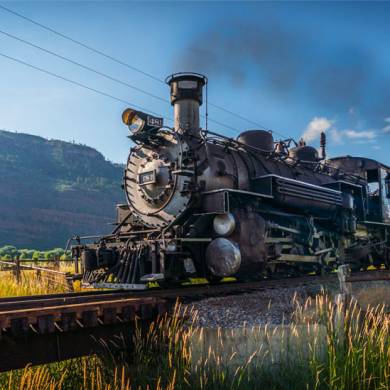Lightning Awareness and Preparedness
Around Durango
“It felt like being stung by 10,000 wasps at the same time, from the inside out,” climber Phil Broscovak recalled of his 2005 lightning strike. Many have told Phil that he is lucky, but he doesn’t always agree. In one sense, it is true, as there is a 90% survival rate. Of those survivors though, more than 70% report intense permanent side effects. Phil has developed a long list of painful daily symptoms he battles more than a decade later. Lightning is a very serious threat for local and visiting hikers out on our mountains.
It is important for you to understand this force of nature so that you can be prepared and remain safe throughout your time around Durango.
Before heading out into the wilderness and outdoor areas around Durango, Colorado, be prepared about how to stay safe from lightning:
Lightning on 14ers: Some Background Info
The majority of our 500,000 lightning strikes occur at mountain elevations. Most are not all that remarkable, striking rocks, metal towers, or trees. People are constantly exploring our mountain ranges though, and yearly casualties number in the lower double-digits. In a pool of data collected over the last 40 years (1980 through 2019), analysts found that 99 deaths and 484 injuries have occurred here on our mountains. This means Colorado has an average of 12 injuries and 2 to 3 fatalities from lightning per year - the third highest in the U.S.
Plan Ahead and Prepare
It is important to pack as light as possible. In case of emergency, this will allow you to respond quickly and cover longer distances. Check the weather forecast in the days leading up to your climb, double-check on the morning of, and get started early. Also, consider climbing lower elevation mountains. The quest to conquer all the 14-ers can be alluring and addictive. Many climbers are opting for shorter mountains though to avoid some of the risks. We have plenty of climbs in the 9,000 - 13,000 foot range that is just as wondrous and challenging as higher peaks.
Start Early, End Early
This is the most important step you can take. Lightning strikes frequently occur mid-day. The old rule of thumb was to summit by 10 am and be off the summit by noon. Because of shifting weather patterns, meteorologists have been detecting lightning as early as 10:30 am more often. Even climbers summiting at 10:00 am have been chased off of 14-ers in a hurry in recent years. So best practice is to start as early as possible and hit the trail at first light.
What to do (and not do) when Lightning Strikes
Do:
Get inside. The only truly safe place during a lightning storm is inside a fully enclosed building or a properly sealed car.
Head down below the tree line and away from the storm. Keep lower than other nearby objects, avoid water, and spread out from other hikers. Lightning can and does jump between bodies (“side flash”), so keep at least 50 feet between you and any other people or small structure.
As a final resort, look for a forest rather than individual tall trees.
Don’t:
Hide in/below a lone tree, gazebo, or open-side shelter. These are insufficient coverage. Even caves or rocky overhangs are not good coverage, as lightning can bounce across rocky surfaces and funnel through enclosures.
Do not lie on the ground. It increases your ground-level surface area, and ground current strikes make up nearly 50% of injuries.
Height, pointy shape, and isolation are the primary factors for why lightning strikes where it does. Avoid anything that fits the description.
Do not waste time shedding gear. Your phone, jewelry, or metal frame pack will not attract lightning. Unless your stuff is slowing you down, just keep moving.
Just remember that there is no such thing as safety when outside during a lightning storm - only a reduction of risk.
Conclusion
It is entirely possible to safely enjoy the excitement and beauty of our 14,000-foot mountains, but the proper precautions must be made. We hope this brief overview will work as a guideline for your next climb. Be safe and have fun.



